¿Sus entradas de WordPress devuelven un error 404 en su sitio web?
Este error se produce cuando puedes acceder al área de administrador y al blog de WordPress, pero cuando intentas abrir una entrada, verás el mensaje “404 No encontrado”.
En este artículo, le mostraremos cómo corregir las entradas de WordPress que devuelven errores 404.
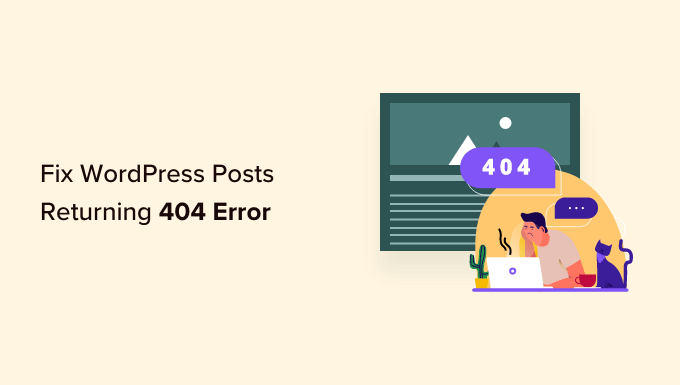
¿Por qué mis entradas de WordPress devuelven un error 404?
Hay varias razones por las que sus entradas de WordPress pueden estar mostrando un error 404 “Página no encontrada”. Estos pueden incluir:
- Conflictos de plugins o temas: A veces, los plugins o temas que has instalado en tu sitio pueden interferir con la forma en que WordPress gestiona los permalinks. Esto puede provocar enlaces rotos y errores 404.
- Problemas de código personalizado: Si has añadido código personalizado a tu sitio web, puede haber errores en el código que estén afectando a los permalinks o causando otros conflictos, dando lugar a errores 404 para tus entradas.
- Problemas con su archivo .htaccess: El archivo .htaccess juega un papel importante en cómo WordPress estructura las URLs. Si este archivo está dañado o no existe, puede provocar errores 404 en las entradas.
Dicho esto, veamos cómo corregir las entradas de WordPress que devuelven errores 404. Puede utilizar los siguientes enlaces para ir directamente a las diferentes soluciones:
Tutorial en vídeo
Si prefiere instrucciones escritas, siga leyendo.
Método 1: Comprobar si hay conflictos de plugins o temas y problemas de código personalizado
A veces, los plugins, temas o código personalizado que has añadido a tu sitio de WordPress pueden interferir con los enlaces permanentes o causar conflictos, dando lugar a errores 404. Incluso lo hemos experimentado nosotros mismos cuando probamos herramientas en nuestro sitio de demostración.
Una forma de resolver este problema es desactivar temporalmente los plugins. Los plugins a veces pueden alterar la forma en que WordPress gestiona los enlaces.
Una vez que hayas desactivado los plugins, puedes reactivarlos uno a uno mientras compruebas si el error 404 reaparece después de activar cada plugin. Si el error aparece después de activar un plugin específico, ese podría ser el culpable.
A continuación, puede buscar soluciones relacionadas con ese plugin o ponerse en contacto con el desarrollador del plugin para obtener ayuda.
Del mismo modo, su tema de WordPress podría estar causando el conflicto.
Para comprobarlo, puedes cambiar temporalmente a un tema predeterminado de WordPress como Twenty Twenty-Three o Twenty Twenty-Four. Solo tienes que ir a Apariencia “ Temas y hacer clic en “Activar” en un tema predeterminado.

Si el error 404 desaparece con el tema predeterminado, indica un posible conflicto con su tema actual. A continuación, puedes intentar solucionar el problema con el tema o considerar la posibilidad de utilizar un tema diferente.
Puede consultar nuestra selección de expertos de los temas de WordPress más populares para obtener recomendaciones.
Si ha insertado recientemente fragmentos de código en su sitio web, es posible que haya errores en el código que causen los errores 404. Examina detenidamente el código que has añadido y comprueba si puedes identificar algún error.
La forma más segura de añadir fragmentos de código a WordPress es con el plugin WPCode. Este plugin te permite insertar código personalizado sin trabajar directamente con los archivos del tema, lo que reduce el riesgo de romper tu sitio web.
Además, siempre que WPCode detecte un error en tu código, desactivará automáticamente el fragmento y te pedirá que lo compruebes. También puedes utilizar el modo de prueba para comprobar si tu código funciona antes de enviarlo a tu sitio web.
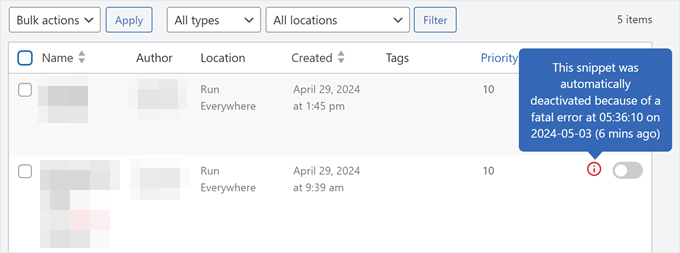
Si ninguna de estas soluciones funciona, pasa al siguiente método en el que solucionaremos los problemas de configuración de tu enlace permanente.
Método 2: Corregir la configuración de Permalink
Las entradas de WordPress pueden devolver errores 404 debido a problemas con las reglas de reescritura en su archivo .htaccess. En la mayoría de los casos, puede corregir el problema actualizando sus ajustes de enlaces permanentes.
Simplemente vaya a Ajustes ” Enlaces permanentes en el administrador de WordPress y haga clic en el botón “Guardar cambios”.
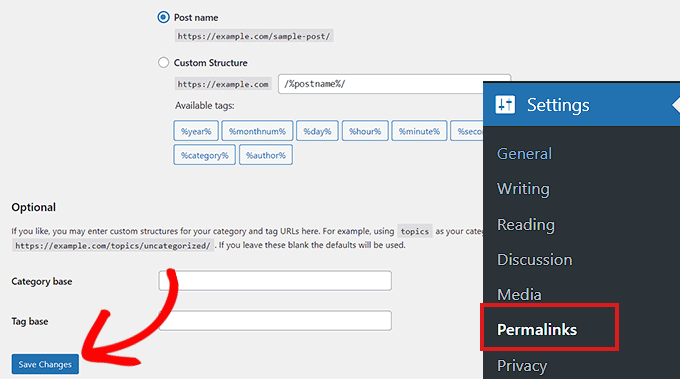
No es necesario realizar cambios en los ajustes de los enlaces permanentes. Esto actualizará los ajustes de enlaces permanentes y eliminará las reglas de reescritura.
En la mayoría de los casos, esta solución corrige el error 404 de las entradas de WordPress. Sin embargo, si no le funciona, probablemente necesite actualizar su archivo .htaccess manualmente.
Método 3: Actualizar el archivo .htaccess de WordPress
Antes de empezar, asegúrese de hacer una copia de seguridad de su archivo .htaccess de WordPress. Si algo va mal, puede restaurar fácilmente el archivo original.
Ahora, tendrá que conectarse a su servidor utilizando un cliente FTP como FileZilla o la aplicación Administrador de Archivos en el escritorio de alojamiento de WordPress.
A continuación, tendrá que encontrar y editar el archivo .htaccess, que se encuentra en la misma ubicación que carpetas como /wp-content/ y /wp-includes/.
Basta con hacer clic con el botón derecho en el archivo y seleccionar “Permisos de archivo”.
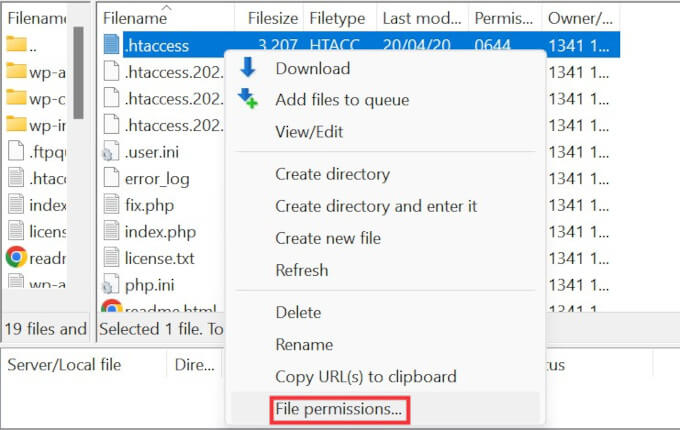
Puede hacer que el archivo sea de escritura cambiando sus permisos a 666.
Basta con introducir “666” en la casilla “Valor numérico” y hacer clic en “Aceptar”.
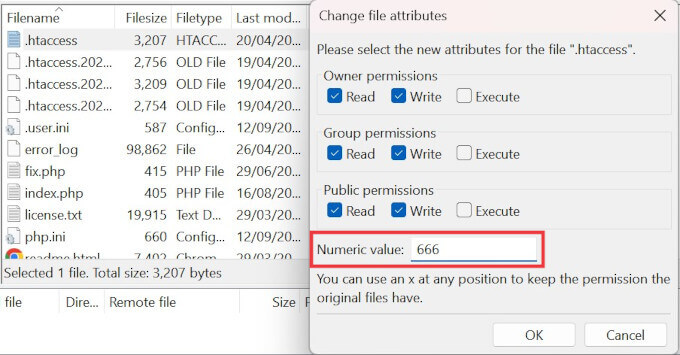
A continuación, debe repetir los pasos del primer método de nuestro tutorial. Una vez hecho esto, no te olvides de cambiar los permisos de nuevo a 660.
También puede editar el archivo y añadirle código.
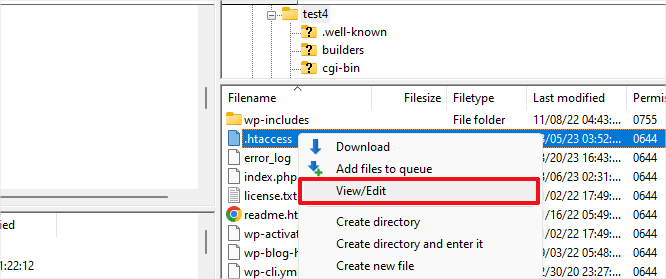
Una vez que haya abierto el archivo .htaccess con un editor de texto, simplemente inserte este código:
# BEGIN WordPress
<IfModule mod_rewrite.c>
RewriteEngine On
RewriteBase /
RewriteRule ^index\.php$ - [L]
RewriteCond %{REQUEST_FILENAME} !-f
RewriteCond %{REQUEST_FILENAME} !-d
RewriteRule . /index.php [L]
</IfModule>
# END WordPress
Método 4: Póngase en contacto con su proveedor de alojamiento
Si ninguna de las soluciones anteriores ha corregido el error 404 de las entradas de WordPress, le recomendamos que se ponga en contacto con su proveedor de alojamiento de WordPress. Es posible que haya un error por su parte o que puedan ayudarte a diagnosticar el problema.
Consulte también nuestra guía sobre cómo solicitar soporte de WordPress correctamente y obtenerlo.
Método 5: Corregir el error 404 de las entradas de WordPress en servidores locales
Si está utilizando un servidor local para realizar pruebas, deberá activar mod_rewrite en la configuración de Apache de su sitio MAMP, WAMP o XAMPP.
Esto permitirá a WordPress generar URLs limpias y evitar el error 404 para entradas y páginas en su servidor local.
La forma de hacerlo dependerá de la plataforma que utilices. Las personas que utilizan XAMPP pueden abrir su panel de control y hacer clic en el botón ‘Config’ dentro de Acciones. Luego, selecciona ‘Apache (httpd.conf)’.
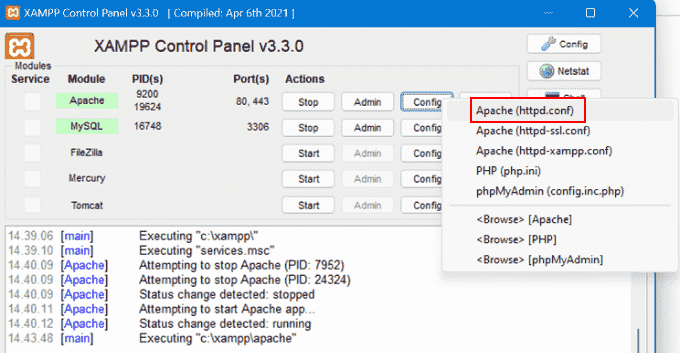
A continuación, tendrá que encontrar esta línea #LoadModule rewrite_module modules/mod_rewrite.so y quitar el ‘#’ para descomentarla.
Esto cargará el mod_rewrite.
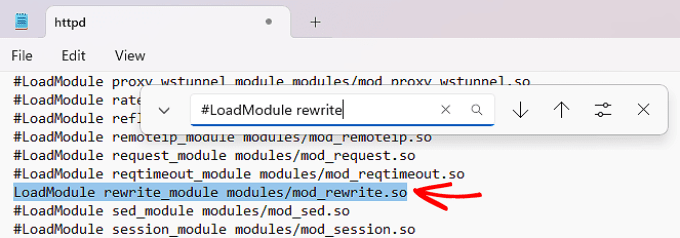
A continuación, busque todas las instancias de AllowOverride None y cámbielas a AllowOverride All.
El valor “Todas” significa que se pueden anular todas las directivas.
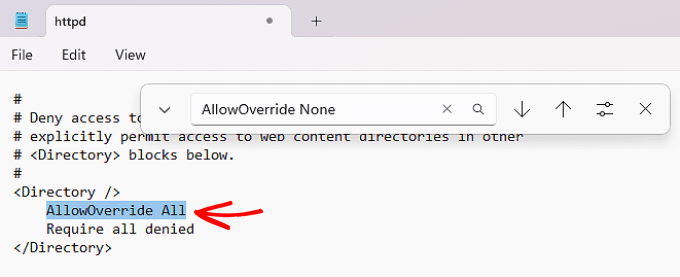
Una vez hecho esto, puedes guardar el archivo httpd.conf y cerrarlo. Después, en el panel de control de XAMPP, haz clic en ‘Detener’ en el módulo Apache y en ‘Iniciar’ de nuevo para reiniciarlo.
A continuación, vuelva a su panel de administrador para ver si sus enlaces permanentes están trabajando.
Esperamos que este artículo te haya ayudado a resolver el problema de las entradas que devuelven errores 404 en WordPress. Puede que también quieras ver nuestra guía sobre los errores más comunes de WordPress y cómo corregirlos, junto con nuestras selecciones de expertos sobre los mejores plugins de WordPress para hacer crecer tu sitio.
If you liked this article, then please subscribe to our YouTube Channel for WordPress video tutorials. You can also find us on Twitter and Facebook.





Syed Balkhi says
Hey WPBeginner readers,
Did you know you can win exciting prizes by commenting on WPBeginner?
Every month, our top blog commenters will win HUGE rewards, including premium WordPress plugin licenses and cash prizes.
You can get more details about the contest from here.
Start sharing your thoughts below to stand a chance to win!
Rj says
thanks man u saved my life
Phannipha says
Thank you for very useful sharing. Just only one click can solve the problem:)
Ehiz Mikey says
A million thanks Syed. I was stuck here for a couple of weeks. A fix indeed.
Kaycee says
Hi. Really nice article.
I had a 500 internal server error issue with my site when I tried using the W3 Total Cache plugin.
To fix this, I renamed the .htaccess file to .htaccessbak. After doing this, I noticed that the 500 error cleared but then I got a 404 error! All the links and pages on my site returned a 404.
On the All Pages section, I see a link that says “Purge from cache”
Please what do I do to clear this issue?
Stanley says
You’re a life saver, worked for me.
Really grateful,
Thank you
syed says
thanks it works for me….
Christian Fraunholz says
but why is that happening and how to fix it forever?
Karma says
I tried to follow your direction in fixing my problem, it took for about a day, but I didn’t find the good result.
Then I gave up and contacted my hosting. And it fixed only in 5 minutes. Lol the problem came from the hosting…
Mark Kay says
By careful with post variables names. I had a contact form with an input field called “name”, that caused WordPress to show the 404 page. Took me a long time to figure out the problem. I fixed it be changing the field name from “name” to “your-name”.
Ivan says
thanks you saved my life.
Ramzan says
My problem is that I m going to wp adminin
And want to edit post it is not going in edit mode of post and page gives me error page not found 404 but my site and its pages are opening well in browser
Plz guide me I can solve this problem
Ben says
Samo rpoblem here. Cannot edit the existing posts or add new one. I get 404 for both
Sunit says
Hi, I have tried following the above steps but my issue is this: when I visit my website directly by putting typing the url, then it works fine. But, when i type in my site url in google search box and then click on the link from the search results, I get the 404 error or message saying “your connection is not private”.
My website is http://www.example.com but google search result shows it as https://example.com/
So not sure what the issue is. I used to have wordpress.com but now I am dong self-host using HG.
Any help will be appreciated.
Thanks
WPBeginner Support says
www is considered a subdomain of a domain. So basically a site with www and without www will be considered two different sites by search engines. Go to Settings > General page to change your site URL from http://www.example.com to just example.com.
WordPress.com enabled https for all custom domains on WordPress.com. This means Google had already crawled your website with https in the URL. You can install free https using Let’s Encrypt.
Administrador
Paul Nicholson says
Great worked for me thanks!!
Shashdhar S says
Thanks a lot , the second option worked for me ….. Thank you so muich
eliana says
Just THANK YOU!
eli
WPBeginner Support says
You are welcome Don’t forget to follow us on Twitter for more WordPress tips.
Don’t forget to follow us on Twitter for more WordPress tips.
Administrador
Michaela says
hi, I tried first solution, nothing happened. I wanted to try the second, but I cannot find the .htaccess file. Not in FTP, not even in my WP online editor. I had this issue today for the first time. I use WPML plugin, until now everything went without problem, but today my translated post in English throws this 404 Error. Any idea what shall I do if I cannot locate the .htaccess file?
Thanks!
Michaela says
I noticed one thing. The post in the editor shows me the following link:
example.com/2016/09/15/where-eat-in-barcelona/?lang=en
but when I click to see the post, or from any RSS feed click on the published post, the link showing 404 error is as follows:
example.com/?p=11409&lang=en
WPBeginner Support says
Please take a look at our guide on why you can’t find .htaccess file on your WordPress site.
Administrador
Shirish Dhungel says
Well thanks! I remember, that WP Super Cache official stated to remove rewrite code from .htaccess. After that, my posts redirected to 404. Thanks to you, now my site is perfectly fine.
Muhammad Nasir says
Thanks it worked for me, thank you so much.
Akhelesh says
Do I have to remove the code snippet I added to htacces file after my problem has been solved?
Jessica says
Can someone contact me please? I am so new to these I don’t even know what a FTP server is…
WPBeginner Support says
Please see our guide on using FTP.
Administrador
Rohan khamkar says
Sir, when I post a new post it gives me error that 404 page not found. Previously everything was fine but when I add a new user and give him a role of administrator from that time I can’t post new post. Any solution Please. Thank you in advance.
WPBeginner Support says
You should never give administrator role to a user you don’t trust. You can always change back their role by going to Users page and then clicking on the Edit link below the user that you want to change. After that you check your site’s permalink structure. See if they installed any new plugin and if they did, then deactivate that plugin.
Administrador
Shivani Sehdev says
Wow……….. Solved a long ago problem .
Thanks A lot.
R Donahoo says
Didn’t work on my apache server. Had an additional step to allow mod_rewrite to actually work. Edit your httpd.conf file and add ‘Allowoverride all’. For example:
DocumentRoot /var/www
find the section that sets up the directory options, such as:
Options Indexes FollowSymLinks MultiViews
Order allow,deny
allow from all
add Allowoverride all
Options Indexes FollowSymLinks MultiViews
AllowOverride all
Order allow,deny
allow from all
save and restart the web server to re-read the updated configuration.
All was well after that.
Thanks for your useful post moving me into the right direction.
Arnaud says
forgot about htis #yaDaMan
Ben says
Didn’t work for me either
Where can I find this file you are talking about
aderele olutayo samuel says
this worked. …. Thanks
Eva says
I found the some problem. However, I could not log in to the admin page. Could you give solution to mitigate this problem?
Rodrick Green says
This was very easy and very helpful. THANKS A LOT!!!
B Pandey says
thanks for your usefull tip. It worked for me on my website. Thanks a lot
sheldon says
Thank you .
It worked for me
Rachit Sharma says
but not working for me when i updated permalink with post name and change .htcces file but not worked. any other solution for that.
Ahsan says
Wowww Thank you so much, that was really helpful.
In my case it was WAMP server, after turning on “rewrite module” in apache, my problem was solved.
Thanks.
Kailash says
Wow – this still works. Done a search on google and found articles in wordpress but this was by far the simple-est and bang it works.
Thanks a mill – saved me a heap of time
WPBeginner Support says
Glad you found it helpful.
Administrador
Shawn Ritch says
Hello and thanks for all the useful tips. Unfortunately, this tip didn’t work for me. I re-saved my permalinks in WordPress settings (didn’t work) so then I tried your next method and it didn’t work either. I’m thinking the reason for this is because I have different permissions. My original permission is 644. When I change permission to 660 none of my pages work so I believe the 666 permission is wrong as well. I’m using a Go Daddy server if that helps any :/
I’m at a loss and have no idea what to do from here. However, I can’t afford to have pages that don’t work. Any suggestions would be greatly appreciated.
Thanks
Shawn Ritch
Kevin Garcia says
I tried this and it didn’t help me!!! My whole website crashed and had to restore it!!
Hannah Brown says
Thanks, yours was the only place that told me HOW to fix my broken links! You’re the best
WPBeginner Support says
Glad you found it helpful.
Administrador
Kunal Yande says
Thanks !!
You save my so much time….
Chris says
How do I fix the issue when I upload a new plugin and then my categories, not posts, become 404?
Bob says
This is great advice. I thought I was going to have to take a deep dive, but two clicks and I’m GTG. Thanks!
Ronn Reason says
hi
i keep getting this message with my email account;
Error Oops… a server error occurred and your email was not saved. (#404)
Please advise ASAP
Gabo says
O.O
I can’t belive this …. it works, thanks !!!!!
Steve says
I had this problem after moving sites to a new server. Default Permalinks worked, but not the settings I was using.
I needed the apache server to “Allow Override” for the htaccess file to take effect.
Vivek says
Hi,
I need a little help regarding 404 error.
I am getting 404 error in my Page 2 section.
I have googled a couple of times. but did not get the solution.
Could you please tell me what is the reason for it?
Rudy says
My site links will work ONLY after I’ve VIEWED the permalink settings, without any changes, and Voila! The links work again. What is causing this and how can I program this instead of having to log in?
I’ve tried the following commands in WP-CLI to no avail:
wp rewrite flush –hard –path=c:\xampp\htdocs\mywordpress
wp cache flush –path=c:\xampp\htdocs\mywordpress
Amit Schandillia says
This saved my life!!!!!
Patrick says
Thanks man, just pressing the “Save changes” on the permalink-settings page did it for me! Cheers!
Amanda says
Hi there,
About an hour ago I was able to remedy a pesky ‘500 Internal Service Error’ by following your sage advice and renaming the .htaccess file to .htaccess_old. I was immediately able to access my wp-admin area–and I thought–get going again.
Unfortunately, something happened which rendered all of my other pages unfindable; each kicking a 404 error.
I attempted the steps you provided above, but to no avail. Might you have any further suggestions?
Thank you.
Jessa says
You guys are awesome, this was easy and fast. You guys save me a trouble!
mehdi says
why i coudl not see my post?
after I send a post my preveous posts appear.
it made me crazy please remove previous post
…
I found a solution to my problem and will say in next post
mehdi says
Hello agin
thank you for this useful article/ I found a bug in wordpress in rtl language in displaying permalink
I read your article and encourage to solve the problem with your contribute.
——————————————
my problem in detail:
1-I created a mysql database(in utf8 general ci)
2-I installed last wordpress versin(locally) and install my theme(multiup v 1.2 from themeforst)
3-Next I did import demo as whele.
in the theme admin panel exixst category portfolio (in this section we create our category with name and slug) then in all post under portfolio section we can create our posts and determine category of post from portfolio category) finally in homepage we have a section that shows portfolio post in category(with their picture)
In english slug and name the category of portfolio show well but when i change category in portfolio category( slug) into rtl language the category in homepage canvert into charachter like base 64(I think that my slug convert into ansi ie each character convert into 6 charachter)
How I can overcome my problem?I think I must avoid change slug or show slug into utf8 or unicode . I am beginer in wpordpress , If I khnew wordpress more I could solve this simple problem .Any one with khnowledge of handling hoock and filter and plugin and wordpress can solve this permalink problem . I sure I will solve this problem with your help.
———————————-
I tried the second way you offer (that phpmyadmin in utf8generalci) but it doee not work for me.
before thansk a lot for helping me.I followed your posts regularly .
……………………………….
1- first I did the trick in above article (this is so good but didnot solve my problem)
2-
mehdi says
hello
thanks to contribute you knowledge to others .my english is not well.excuse me.
I download a wordpress theme with portfolio link in admin panel that in porftoli section we can define some category with name and slug . in post we can determine category from portfolio.
in homepage we can display post in portfolio category! all thing is ok but wen i chang name and slug into rtl language the title of a group in home page shows like this %d8%a8%d8%b1%d9%86%d8%af%d8%b3%d8%a7%d8%b2%db%8c
i did your solution in this topic and that another topic(How To Enable Custom Permalinks) but not woks for my problem!
WPBeginner Support says
This could happen if your WordPress database is not using UTF-8 character encoding. Please make sure that your database is using utf8_general_ci as collation. You can check that using phpMyAdmin from cpanel. Before you make any changes to your database, please create a complete WordPress backup first.
Administrador
Atula Gupta says
Thank you so much for fixing my problem in seconds! I was panicking about all my posts giving this error and this solution was so simple! Thanks again.
Sammy says
Thank you, thank you! This was making me crazy and you just helped me fix it in 2 seconds. High five.